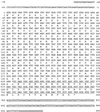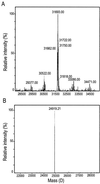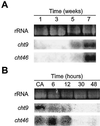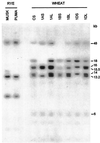Chitinase genes responsive to cold encode antifreeze proteins in winter cereals
- PMID: 11080301
- PMCID: PMC59223
- DOI: 10.1104/pp.124.3.1251
Chitinase genes responsive to cold encode antifreeze proteins in winter cereals
Abstract
Antifreeze proteins similar to two different chitinases accumulate during cold acclimation in winter rye (Secale cereale). To determine whether these cold-responsive chitinases require post-translational modification to bind to ice, cDNAs coding for two different full-length chitinases were isolated from a cDNA library produced from cold-acclimated winter rye leaves. CHT9 is a 1,193-bp clone that encodes a 31.7-kD class I chitinase and CHT46 is a 998-bp clone that codes for a 24.8-kD class II chitinase. Chitinase-antifreeze proteins purified from the plant were similar in mass to the predicted mature products of CHT9 and CHT46, thus indicating that there was little chemical modification of the amino acid sequences in planta. To confirm these results, the mature sequences of CHT9 and CHT46 were expressed in Escherichia coli and the products of both cDNAs modified the growth of ice. Transcripts of both genes accumulated late in cold acclimation in winter rye. Southern analysis of winter rye genomic DNA indicated the presence of a small gene family homologous to CHT46. In hexaploid wheat, CHT46 homologs mapped to the homeologous group 1 chromosomes and were expressed in response to cold and drought. We conclude that two novel cold-responsive genes encoding chitinases with ice-binding activity may have arisen in winter rye and other cereals through gene duplication.
Figures









Similar articles
-
Ethylene induces antifreeze activity in winter rye leaves.Plant Physiol. 2001 Jul;126(3):1232-40. doi: 10.1104/pp.126.3.1232. Plant Physiol. 2001. PMID: 11457973 Free PMC article.
-
Characterization of cold-responsive extracellular chitinase in bromegrass cell cultures and its relationship to antifreeze activity.Plant Physiol. 2008 May;147(1):391-401. doi: 10.1104/pp.106.081497. Epub 2008 Mar 21. Plant Physiol. 2008. PMID: 18359848 Free PMC article.
-
Genes encoding chitinase-antifreeze proteins are regulated by cold and expressed by all cell types in winter rye shoots.Physiol Plant. 2001 Jul;112(3):359-371. doi: 10.1034/j.1399-3054.2001.1120309.x. Physiol Plant. 2001. PMID: 11473693
-
Calcium interacts with antifreeze proteins and chitinase from cold-acclimated winter rye.Plant Physiol. 2004 May;135(1):364-76. doi: 10.1104/pp.103.038158. Epub 2004 Apr 30. Plant Physiol. 2004. PMID: 15122015 Free PMC article.
-
Antifreeze proteins in overwintering plants: a tale of two activities.Trends Plant Sci. 2004 Aug;9(8):399-405. doi: 10.1016/j.tplants.2004.06.007. Trends Plant Sci. 2004. PMID: 15358271 Review.
Cited by
-
Genome-Wide Identification and Expression Analysis of Chitinase Genes in Watermelon under Abiotic Stimuli and Fusarium oxysporum Infection.Int J Mol Sci. 2024 Jan 4;25(1):638. doi: 10.3390/ijms25010638. Int J Mol Sci. 2024. PMID: 38203810 Free PMC article.
-
Deep-sequencing transcriptome analysis of chilling tolerance mechanisms of a subnival alpine plant, Chorispora bungeana.BMC Plant Biol. 2012 Nov 21;12:222. doi: 10.1186/1471-2229-12-222. BMC Plant Biol. 2012. PMID: 23171377 Free PMC article.
-
Wheat EST resources for functional genomics of abiotic stress.BMC Genomics. 2006 Jun 13;7:149. doi: 10.1186/1471-2164-7-149. BMC Genomics. 2006. PMID: 16772040 Free PMC article.
-
Exogenous application of salicylic acid improves freezing stress tolerance in alfalfa.Front Plant Sci. 2023 Mar 9;14:1091077. doi: 10.3389/fpls.2023.1091077. eCollection 2023. Front Plant Sci. 2023. PMID: 36968407 Free PMC article.
-
A Na2CO3-Responsive Chitinase Gene From Leymus chinensis Improve Pathogen Resistance and Saline-Alkali Stress Tolerance in Transgenic Tobacco and Maize.Front Plant Sci. 2020 Apr 28;11:504. doi: 10.3389/fpls.2020.00504. eCollection 2020. Front Plant Sci. 2020. PMID: 32411170 Free PMC article.
References
-
- Altschul SF, Gish W, Miller W, Meyers EW, Lipman DJ. Basic local alignment search tool. J Mol Biol. 1990;215:403–410. - PubMed
-
- Antikainen M, Griffith M. Antifreeze protein accumulation in freezing-tolerant cereals. Physiol Plant. 1997;99:423–432.
-
- Beintema JJ. Structural feature of plant chitinases and chitin-binding proteins. FEBS Lett. 1994;350:159–163. - PubMed
-
- Bradford MM. A rapid and sensitive method for the quantitation of microgram quantities of protein utilizing the principle of protein-dye binding. Anal Biochem. 1976;72:341–374. - PubMed
Publication types
MeSH terms
Substances
LinkOut - more resources
Full Text Sources

